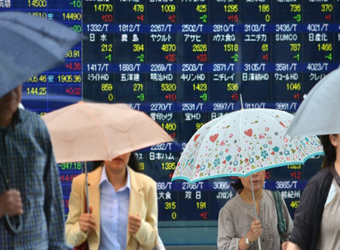Markets in Asia traded mostly lower on Thursday, following a mixed close in U.S. equities overnight as minutes from the Federal Reserve’s previous meeting hinted that a rate hike is coming fairly soon.
In Japan, the Nikkei 225 traded down 0.27 percent, while across the Korean Strait, the Kospi was fractionally lower at 2,106.13. Hong Kong’s Hang Seng index was off by 0.46 percent, while Chinese mainland markets also traded lower.
The Shanghai composite was down 0.39 percent and the Shenzhen composite fell 0.29 percent.
Australia’s ASX 200 fell 0.27 percent in afternoon trade, with gains in most sectors offset by a nearly two percent drop in the materials sector.
Major miners in the country traded lower, with Rio Tinto down 5.51 percent, Fortescue off by 1.86 percent and BHP Billiton down 2.64 percent.
Qantas reported first-half underlying profit before tax fell 7.5 percent on-year to 852 million Australian dollars for the six months ended December 31, 2016, but was above the guidance range provided in October. Qantas shares were up 5.07 percent.
Nissan announced it was appointing its co-CEO, Hiroto Saikawa, to be the chief executive officer as of April 1.
Carlos Ghosn, who is chairman of the board and current CEO, will continue to serve as chairman and will seek a renewal of mandate at Nissan’s general shareholders meeting in June. Nissan shares slipped 0.85 percent.
Elsewhere, Reuters reported that South Korea’s SK Hynix will consider making a fresh bid for Toshiba’s flash memory chip business if the Japanese conglomerate offers more of it for sale.
On Wednesday, the Nikkei business daily reported that Toshiba asked potential bidders for the memory chip business to peg the unit’s operations’ value at 2 trillion yen ($17.6 billion) or more.
Toshiba shares were down 7.08 percent, while SK Hynix fell 1.19 percent.
In the currency market, the dollar index traded at 101.29 at 11:50 a.m. HK/SIN.
Analysts said the Fed’s meeting minutes failed to give the dollar a lift that many had been waiting for.
Matt Simpson, senior market analyst at ThinkMarkets, said in a note the greenback reconsidered breaking above 101.74 resistance, yet it’s failure to do so for the second occasion in a week suggest potential for near-term weakness.
Simpson added in the absence of major data, unless there are further details on U.S. President Donald Trump’s tax schemes or fiscal stimulus, the dollar is expected to remain capped for the week.
The yen traded at 113.20 to the dollar, strengthening from levels near 113.45, while the Australian dollar fetched $0.7686. The euro traded at $1.0565.
South Korea’s central bank kept interest rates unchanged on Thursday in a widely expected move, leaving the base rate steady at 1.25 percent.
Eugenia Victorino, Asia economist at ANZ, said there is still room for further monetary easing from Bank of Korea by the end of the second quarter.
“Overall growth is showing some signs of improvement on the back of a pick-up in exports,” she said. “However, domestic demand remains soft … (and) … various indicators, aside from the gains in the CPI, suggest that underlying inflationary pressures are still weak.”
The Korean won traded at 1,137.70 to the dollar, strengthening from levels near 1,141.70 earlier in the session.
Oil traded higher Thursday morning Asia time, with U.S. crude up 0.90 percent at $54.07 a barrel, while Brent climbed 0.86 percent to $56.32.
Data from the American Petroleum Institute showed on Wednesday crude inventories fell by 884,000 barrels in the week to February 17 to 512.7 million, compared with analysts’ expectations for an increase of 3.5 million barrels, Reuters reported.
Source: CNBC


